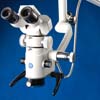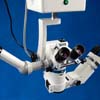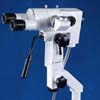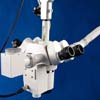The Development Of The Eye
The initial stages in the formation of the visual organ are so intimately related to those of the brain, that a brief sketch of the early development of the nervous system may with advantage precede the more detailed account of the development of the eye. The first definite trace of the embryo within the embryonal area appears as a pair of slightly converging fold s, the medullary plates, which partially enclose the anterior end of the transient primitive streak. Originally widely separated and low, the forlds rapidly increase in height, while the included neural groove becomes correspondingly deepened. Very soon the growing medullary plate manifest a tendency to approximate their free edges along the dorsal aspect of the embryo, a disposition with eventually results in their fusion and the conversion of the neural groove into the closed.18 EMBRYOLOGY, ANATOMY, AND HISTOLOGY OF EYE.
Neural canal. The point a which this fusion earliest occurs does not coincide with the anterior extremity of the canal, but with a point somewhat farther back ; form the this latter situation closure progresses towards the caudal pole.
The anterior extremities of the medullary folds remain ununited for some time after the more caudally situated parts of the folds have undergone concrescence and closure ; the anterior portion of the folds, on the other hand, has meanwhile become locally expanded in such manner that even before the fusion of the indications of three distinct – the primary brain vesicles have become apparent. The foremost of these, the anterior brainsac, occupies the extreme end of the neural canal, and is of large size the succeeding middle and posture vesicles being less expanded, although of greater length.
PRIMARY OPTIC VESICLES.
The primary cerebral vesicle, however, soon undergo further change since the anterior and the posterior each becomes subdivided, the cephalic segment of the neural tube being then represented by the five secondary brain-vesicles. These latter are designated , from before backward, as the fore-brain, or prosencephalon ; the inter-brain, or encephalon ; the mid-brain, or mesncephalon ; the mid-brain, or mesencephalon ; the hind-brain, or epencephalon ; and the ater brain, or metencephalon. The remains of greatly and relatively reduced cavities of these early brain-segments are represented respectively by the lateral ventricles, the third ventricles, the aqueducts o Sylvius, and the fourth ventricles ; while from the alls of the secondary brain-vesicles are development the structures situated around the corresponding part of the ventricular space.
Coincidently with the development of the primary cerebral vesicles, even before the complete closure of the neural canal, the anterior brain-sac become distinguished by the evagination of conspicuous diverticulum on either side, which extends almost at right angles to the general cerebral axis. These outgrowth from the hinder part of the early anterior cerebral segment are the primary optic vesicles, from which the nervous tunic of the eye is largely developed. The optic vesicles at first opens so widely into the brain-sac that there is little differentiation of the ocular rudiment from the
Back to Resources
call toll-free:  or email
or email

 or email
or email
Categories
Categories
Dental
Dental Microscopes
Dental Microscopes
Ophthalmic
Ophthalmic Microscopes
Ophthalmic Microscopes
Gynecology
Gynecology Colposcopes
Gynecology Colposcopes




